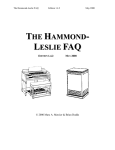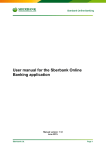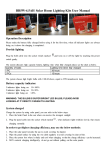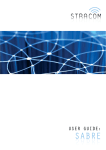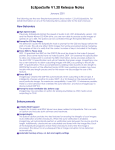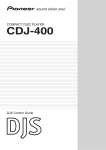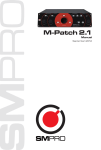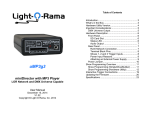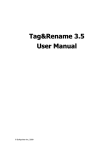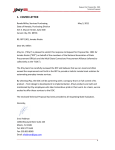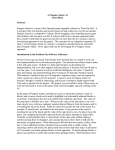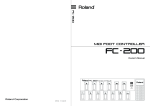Download Comments on ISO Committee Draft 3901 (2nd)
Transcript
ISO/TC 46/SC 9 Secretariat ISO/TC 46/SC 9 Secrétariat National Library of Canada 395 Wellington Street Ottawa, CANADA K1A 0N4 Bibliothèque nationale du Canada 395, rue Wellington Ottawa, CANADA K1A 0N4 Telephone - Téléphone (819) 994-6939 Fax : (819) 953-0291 Internet: [email protected] Web site: <http://www.nlc-bnc.ca/iso/tc46sc9/index.htm> 264 ISO/TC 46/SC 9 N 1999-04-27 To: Members of ISO/TC 46/SC 9 International ISRC Agency (IFPI) Selected liaison organizations cc. C. Deschamps, ISO/TC46/SC9 Chairperson S. Clivio, ISO Central Secetariat SUBJECT: Results of voting and comments on ISO Committee Draft 3901 (2nd), “Information and documentation -- International Standard Recording Code (ISRC)” The attached document shows the results of voting and comments on the second ISO Committee Draft 3901 (TC 46/SC9 N 257). CD 3901 is a revision of ISO 3901:1986, the ISO standard for the International Standard Recording Code (ISRC). ACTIONS REQUIRED: • For immediate distribution to delegates to the May 1999 meeting of ISO/TC 46/SC 9; • For response by the International ISRC Agency (IFPI) and the project leader; • For discussion on May 18, 1999 during the ISO/TC 46/SC 9 meeting in Paris, France. This document and a copy of CD 3901 (2nd) are also available on the ISO/TC 46/SC 9 Web site at: <http://www.nlc-bnc.ca/iso/tc46sc9/3901.htm>. With regards, [original signed by] Jane Thacker Secretary, ISO/TC 46/SC 9 ISO International Organization for Standardization TC 46 Information and Documentation SC 9 Presentation, Identification and Description of Documents ISO Organisation internationale de normalisation TC 46 Information et documentation SC 9 Présentation, identification et description des documents ISO/TC 46/SC 9 N 264 1999-04-27 TABLE OF REPLIES for ISO Committee Draft 3901 (N 257): Information and documentation -- International Standard Recording Code (ISRC) P-Members of ISO/TC46/SC9 (22) Approve Australia Disapprove Abstain X Canada Comments X X -- China, P.R. Czech Republic X X X -- Denmark Finland France Germany X X X -- X -- Norway X -- Poland X X Hungary Iran Italy Japan Netherlands Portugal X -- Russian Federation X X Spain X -- Sweden X -- U.K. X South Africa X U.S.A. X TOTAL 8 [i.e. 80%] Additional comments received from: X 2 [i.e. 20%) 6 - IFPI and the national ISRC agencies for Japan, India, Sweden and Germany - NC (Cuba): approval ISO/TC 46/SC 9 N 264 1999-04-27 Comments on ISO Committee Draft 3901 (2nd) International Standard Recording Code (ISRC) Committee Draft 3901 (2nd) was distributed on January 6, 1999 as document TC 46/SC 9 N 257. General comments Czech Republic (CSNI) Owing to the change of the structure of ISRC we suppose that the new edition of the user’s manual will explain what will be with the ISRCs already assigned; how it will be enabled to use them also in the future. Poland (PKN) Controlling ISRC usage: According to 4.2, registrant code is assigned to producer once, at the beginning, and after this time ISRC National Agency has almost no possibility to control use of ISRC. In case of any mistakes or incorrect usage of ISRC, the standard described in ISO CD 3901 gives no way of solving the problem. 1 Scope France (AFNOR) We propose to add at the end of the first paragraph : “The purpose… for the unique identification of recordings or part of a recording”. Czech Republic (CSNI) Paragraph 3: In the listing of institutions storing the recordings identified by ISRCs the libraries are missing. But even the libraries could store the recordings. Therefore we recommend to add them to the text as it was in the original edition. Russian Federation (GOST R) The careful analysis of ISO 3901 and the drafts of its revision reveals that the sphere of application of the Standard remains uncertain. Regarding to its text the Draft extends its sphere of application to all sound recordings as well as to audio-and-videorecordings but of musical works only. This inclusion seems to be illogical and gives rise to questions. What is the definition of audio-visual recording? Does a musical movie by itself present 1 ISO/TC 46/SC 9 N 264 1999-04-27 an object forming a part of the application sphere of this Standard? If the answer is “yes”, then where the distinction between a musical movie and a movie with musical accompaniment should be drawn? But even if such a distinction is found, it’ll stay unclear why nonmusical movies and other nonmusical audio-visual recordings should be excluded from the system of registration. If IFPI, being the ISRC Agency, is not ready to operate within such a diaposon [sic - disposition?] of recordings then this diaposon [sic] should be limited with some reasonable criterion. A “musicality” or a “melodiousness” could become some of them. In that case the ISRC should be extended to music audio recordings and music video recordings as well. “Auditivity” could be chosen as a criterion too. In such a case the standard should be extended to sound recordings and to those audiovisual recordings which possess the sound component capable to be named as a leading one, more essential from the point of view of informational or feature content. In any case such sort of definition of the application sphere should be explained clearly. Russian Federation (GOST R) In the text of the standard the ISRC operation sphere should be differentiated from the adjacent spheres (ISMN, ISWC, etc.). U.S.A. (ANSI/NISO) Does this standard apply to what the Anglo American Cataloging Rules, 2nd edition, calls a "nonprocessed sound recording" (i.e., a noncommercial recording that generally exists in a unique copy)? Such recordings do not go through a "full mastering process", so it is assumed that the standard does not apply to these recordings. If that is the case then this exclusion should be explicitly stated. [Secretariat’s note: see also Russian comment below, and Polish comment about remastering under section A.2 (Modified versions)] Russian Federation (GOST R) There are some doubts about what product exactly is to be registered: the final commercial product obtained as a result of audio-video work recording or, by itself an individual mastering process of recording, which is not identical, but only is turned into a commercial product. 2 Normative references France (AFNOR) To be amended : ISO 3166:1997 ISO CD 15706 2 ISO/TC 46/SC 9 N 264 1999-04-27 3 Definitions France (AFNOR) We propose to keep the definition of ISO 3901-1986 : [i.e. Add:] 3.5 Year of reference : the year in which the recording process is completed. 3.2 music video recording Recording Industry Association of Japan (RIAJ) [submitted via IFPI]: Territorial issue to be caused by ISAN RIAJ considers ISO should not allow a registrant to assign both an ISRC and an ISAN to the same audio-visual recording and manage it by overlapped means. It is because, if we assume that ISAN will identify a recording at the same level (or layer) as ISRC, the overlap in the management will cause both coding systems inefficiency in their implementations, also cause both owners of recordings and users confusion. (ref. ISBN or ISWC -- for different levels of identification) From such viewpoint, RIAJ considers the definition of music video recording in the section 3.2 is inadequate for the purpose to avoid the overlap and confusion mentioned above. Accordingly, RIAJ would like to propose adding the following sentences in the section 3.2: “While a border of territories between ISRC and ISAN is vague, an ISRC shall not be overlapped with an ISAN in assignment. To avoid inefficiency and confusion in implementation, it is recommended that a registrant decides a clear rule beforehand to apply each coding system to the management of their recordings.” [see revised wording proposed by IFPI, below] Also, RIAJ considers the same content of the above sentence needs to be involved in the ISAN standard document (ISO CD 10956 [sic; i.e. 15706]). Addition by the International ISRC Agency to the above comment from RIAJ: In our opinion no 1 [i.e. above comment from RIAJ] should have the following wording: “Registrants should ensure that when an ISRC is allocated no similar identifiers should be used.” Recording Industry Association of Japan (RIAJ) [submitted via IFPI]: Section 3.2 NOTE: In many countries and regions, rights in audio-visual recordings are distinguished from those of audio recordings. Thus, there are cases [when] it is hard to release the audio component of a music-video recording as a separate sound recording by only a recordproducer’s intention. It depends on a contract between an artist and a record producer on 3 ISO/TC 46/SC 9 N 264 1999-04-27 production of a music-video recording, and releasing such audio component is not always available (e.g. recordings of live events). Accordingly, RIAJ considers it is preferable to remove the NOTE. 3.3 recording Czech Republic (CSNI) In the listing of carriers the “videos” are missing. We recommend to present them here (as it is in the rest of the text). 4.3 Year of reference element Australia (SAA) Australia does not agree to the circulation of the draft as a DIS. This standard does not address the Y2K problem. This standard has been drafted so that it allows for only two digits in the year field. U.S.A. (ANSI/NISO) The year identifier should be expanded to three or four digits. France (AFNOR) We suggest to modify as follows : “The year of reference element should identify the year in which the recording process is completed. For backstock numbering the year of reference should identify the year in which the ISRC is allocated to the recording.” Annex A: Guidelines for the application of ISRC A.1 General principles for the allocation of ISRC A.1.7 Czech Republic (CSNI) A.1.7: The text following the first sentence (beginning with “However...”) until the end of the paragraph would be more suitable for the user’s manual. It describes practice of assigning the ISRCs in too [much] detail. 4 ISO/TC 46/SC 9 N 264 1999-04-27 A.2 Modified versions Poland (PKN) Remastering: There is quite common problem of remastering of old recordings. Should we assign a new code to a track after re-mastering? A.2.1 Russian Federation (GOST R) Why it is said only about sound recording [in] A.2.1? Probably it should be said “sound recording or music video recording”? A.2.2 Recording Industry Association of Japan (RIAJ) [submitted via IFPI]: Section A.2.2 RIAJ considers, for the future, we should take account of music distribution on digital broadcasting and electronic file delivery system as well as physical carrier. Accordingly, RIAJ would like to propose modifying the head of the sentence as follows: “Changes in the physical and/or electronic carrier, ...” A.2.3 U.S.A. (ANSI/NISO) This text should be clarified. The following text is suggested: "Recordings of live events are to be assigned ISRC¹s in the same manner as are studio recordings." Recording Industry Association of Japan (RIAJ) [submitted via IFPI]: Section A.2.3. RIAJ has gotten some strange feeling by the part “recording of live events should be treated as studio recordings” because it might be unclear. Accordingly, RIAJ would like to propose modifying the whole sentence as follows: “For the purpose of ISRC assignment, recordings of live events should be assigned a separate ISRC in the same manner as studio recordings”. 5 ISO/TC 46/SC 9 N 264 1999-04-27 A.5 Administration of the ISRC system A.5.1 International ISRC Agency Czech Republic (CSNI) To make the text clearer it should be said by whom the International ISRC Agency is appointed. A.5.2 National ISRC agencies German ISRC Agency [submitted via IFPI]: The German group is wondering why under point A.5.2, national ISRC agencies should annually notify of first registrant codes. Furthermore it wonders why under point A.5.3 the notification of in-college recordings is necessary. It was already available in phono-net. Other annexes France (AFNOR) Furthermore we suggest to add an annex designed as Annex D of CD 15706 (ISAN) : Support information for registration of a recording. In order to adequately describe the specific recording to which an ISRC is allocated, registrants shall supply the ISRC agency with a specified amount of descriptive support information about the recording registered. These information shall be maintained by the ISRC agencies. The specifications concerning the type and format of this support information should be established in accordance with the IV 6 chapter of the Practical guide (2nd edition, 1992) published by the International ISRC agency. Recording information Recording format (audio/audio-visual) Recording system (mono/stereo, analogue/digital) (P) date (year date of first publication) Place of recording (place where the majority of recording costs are incurred) Playing time Producer (the artistic supervisor) Engineer 6 ISO/TC 46/SC 9 N 264 1999-04-27 Re-mixer (the person who manipulates the original master tape to change the final balance of recording) Work information Title Composer(s) Arranger(s) Text writer(s) (lyricist) Language Publisher (in the country in which ISRC is generated, if know) Artist information (pop) Main artist(s) Featured artists Session artists Artist information (classical) Soloist(s) Ensemble Performer(s) Orchestra Conductor Chorus or vocal group Chorus conductor (master) Other comments IMI (Indian Music Industy) [submitted via IFPI]: We have gone through the document and request for your response on the following points: a) In order to distinguish between audio and audio-visual recording a standardised method may be suggested. b) The primary purpose of ISRC is to identify the digital recording during its life time. The ISRC number will not change if the copyright owner changes without any change in the recording. We shall be grateful if you clarify how ISRC can help in royalty accounting to the owners assignee or transferee in such a situation. c) May we request you to forward us the specified format for exchange of ISRC information between Registrants and National ISRC Agency. 7 ISO/TC 46/SC 9 N 264 1999-04-27 Swedish ISRC Agency [submitted via IFPI]: An update and a few comments on ISRC from the Swedish IFPI Group: We still allocate ISRC first owner codes for both audio and video. All members encode their phonograms and videograms (might be 90 % of the videograms). Talking about the non-member companies we have pretty good contact with them, most of the companies with regular production of phonograms are members of our local society, but those who more sporadically produce phonograms do take contact with us to get a first owner code. Today, we have allocated close to 400 first owner codes in Sweden. Members of the national group are 55 individual record companies. Our database contains ISRC fields. We have a new database for the use of ISRC in connection to our work with rights administration/collecting society. We do not get the ISRC automatically but when we ask for the codes we often receive the information electronically. We are having problems with collecting the ISRC codes, in order to build up our ISRC databases. We constantly have to remind the companies. Do you know if the situation is the same for all ISRC agencies or is it not common to collect the codes? Of course a database with ISRC codes is valuable information in itself, but our goal is combine it with the administration of remuneration to rightowners. This has so far been the main reason for the record companies to put codes on the phonograms and videos but the longer it takes for users/broadcasters to start reporting the codes the harder it will be to uphold the interest and motivation to code the recordings. The administration savings could be quite big for both rightowners and users if the system was in use. We really hope that the work with watermark will be successful so that we can see some practical use of the ISRC. 8










